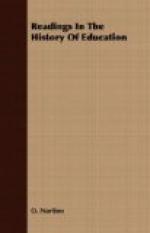The books above mentioned did not constitute the sole resources for higher education. Besides the already long-used text-books on the Seven Liberal Arts there were mathematical and philosophical works of Arabic origin, and as the revival progressed many new books were written on the old subjects. But the books already named were fundamentally important as furnishing not only the early intellectual impulse to the growth of universities, but also the main body of studies in the Faculties of Arts, Theology, Law, and Medicine down to the year 1500. Many of them were in use at a much later date, and some—with many revisions—are still standard text-books. No one can understand the intellectual life of the universities who does not have some acquaintance with the titles and contents of these works. It may be added that acquaintance with them is essential also to the understanding of European history and literature. This section is therefore devoted to certain details concerning the early history of university studies.
(a) The Works of Aristotle
The works of Aristotle were composed in Athens, 335-322 B.C. Their history, from the time of Aristotle’s death to their appearance in Latin translations in western Europe, fifteen hundred years later, cannot be here detailed. The translations commonly used in the universities were nearly all made during the twelfth and thirteenth centuries. The earlier ones were made in Spain, from Arabic versions of the original Greek; the later, directly from Greek copies found in Constantinople, and elsewhere in the East. The Arabic-Latin translations were very poor, owing to the two removes from the original Greek and the incapacity of the translators. Those directly from the Greek were somewhat better, yet far from satisfactory; and new versions were repeatedly made down to the end of the fifteenth century. University reforms sometimes included the adoption of these better translations (see p. 48).
The works known by the year 1300 may be classified in four groups:
{1. Categories = {Predicamenta.
I. Logical { {Categoriae. treatises {2. On interpretation = {De Interpretatione. commonly { {Peri Hermeneias. referred to {3. Prior Analytics = Analytica Priora. as the Organon {4. Posterior Analytics = Analytica Posteriora. or {5. Topics = Topica. Methodology {6. Sophistical} = Sophisticae Elenchi.
{ Refutations}
II. Moral {7. Politics.
and Practical {8. Ethics.
Philosophy {9. Rhetoric.
{10.
Poetics.
{11.
A Physical Discourse (Physics).
{12.
On the Heavens.
{13.
On Generation and Destruction.
{14.




